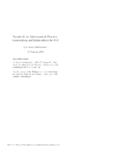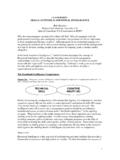Transcription of Progressions for the Common Core State Standards …
1 Progressions for the Common CoreState Standards in Mathematics (draft)c The Common Core Standards Writing Team21 April 2012 Draft, 4/21/2012, comment 5, Number andOperations in Base TenOverviewStudents work in the base-ten system is intertwined with their workon counting and cardinality, and with the meanings and propertiesof addition, subtraction, multiplication, and division. Work in thebase-ten system relies on these meanings and properties, but alsocontributes to deepening students understanding of base-ten system is a remarkably efficient and uni-form system for systematically representing all numbers.
2 Using onlythe ten digits0,1,2,3,4,5,6,7,8,9, every number can be repre-sented as a string of digits, where each digit represents a value thatdepends on its place in the string. The relationship between valuesrepresented by the places in the base-ten system is the same forwhole numbers and decimals: the value represented by each placeis always10 times the value represented by the place to its imme-diate right. In other words, moving one place to the left, the valueof the place is multiplied by10. In moving one place to the right,the value of the place is divided by10.
3 Because of this uniformity,standard algorithms for computations within the base-ten system forwhole numbers extend to unitsEach place of a base-ten numeral represents abase-ten unit: ones, tens, tenths, hundreds, hundredths, etc. Thedigit in the place represents0to9of those units. Because tenlike units make a unit of the next highest value, only ten digits areneeded to represent any quantity in base ten. The basic unit isaone(represented by the rightmost place for whole numbers). Inlearning about whole numbers, children learn that ten ones com-pose a new kind of unit called aten.
4 They understand two-digitnumbers as composed of tens and ones, and use this understandingin computations, decomposing1ten into10ones and composing aten power of the base-ten system is in repeated bundling byten:10tens make a unit called a hundred. Repeating this process ofDraft, 4/21/2012, comment new units by bundling in groups of ten creates units calledthousand,ten thousand,hundred thousand.. In learning aboutdecimals, children partition a one into10equal-sized smaller units,each of which is a tenth.
5 Each base-ten unit can be understood interms of any other base-ten unit. For example, one hundred can beviewed as a tenth of a thousand,10tens,100ones, or1 for operations in base ten draw on such relationshipsamong the base-ten algorithms for base-ten computations withthe four operations rely on decomposing numbers written in base-ten notation into base-ten units. The properties of operations thenallow any multi-digit computation to be reduced to a collection ofsingle-digit computations. These single-digit computations some-times require the composition or decomposition of a base-ten in Kindergarten, the requisite abilities develop grad-ually over the grades.
6 Experience with addition and subtractionwithin20is a Grade 1 fluency is a Grade and subtract within 20, demonstrating fluency for ad-dition and subtraction within 10. Use strategies such as countingon; making ten ( ,8682410414); decom-posing a number leading to a ten ( ,13413311019); using the relationship between addition and subtrac-tion ( , knowing that8412, one knows1284); andcreating equivalent but easier or known sums ( , adding67by creating the known equivalent66112113). within20that cross 10, such add and subtract within 20 using mental end of Grade 2, know from memory all sums of twoone-digit , are especially relevant to NBT because they afford thedevelopment of the Level 3 make-a-ten strategies for addition andsubtraction described in the OA Progression.
7 From the NBT per-spective, make-a-ten strategies are (implicitly) the first instances ofcomposing or decomposing a base-ten unit. Such strategies are afoundation for understanding in Grade 1 that addition may requirecomposing a in Grade 2 that subtraction may within 100, including adding a two-digit number anda one-digit number, and adding a two-digit number and a multipleof 10, using concrete models or drawings and strategies basedon place value, properties of operations, and/or the relationshipbetween addition and subtraction; relate the strategy to a writ-ten method and explain the reasoning used.
8 Understand thatin adding two-digit numbers, one adds tens and tens, ones andones; and sometimes it is necessary to compose a a and subtract within 1000, using concrete models ordrawings and strategies based on place value, properties of op-erations, and/or the relationship between addition and subtrac-tion; relate the strategy to a written method. Understand thatin adding or subtracting three-digit numbers, one adds or sub-tracts hundreds and hundreds, tens and tens, ones and ones;and sometimes it is necessary to compose or decompose tens and algorithmsThe Standards distinguish strategiesfrom algorithms.
9 For example, students use strategies for addition Computation set of predefined steps applicableto a class of problems that gives the correct result in every casewhen the steps are carried out correctly. See also: manipulations that may bechosen for specific problems, may not have a fixed order, andmay be aimed at converting one problem into another. See also:computation subtraction in Grades K-3, but are expected to fluently addand subtract whole numbers using standard algorithms by the endof Grade 4.
10 Use of the standard algorithms can be viewed as theculmination of a long progression of reasoning about quantities, thebase-ten system, and the properties of progression distinguishes between two types of computa-tional strategies: special strategies and general methods. For ex-ample, a special strategy for computing39817is to decompose17as215, and evaluate398215. Special strategies eithercannot be extended to all numbers represented in the base-ten sys-tem or require considerable modification in order to do so.














